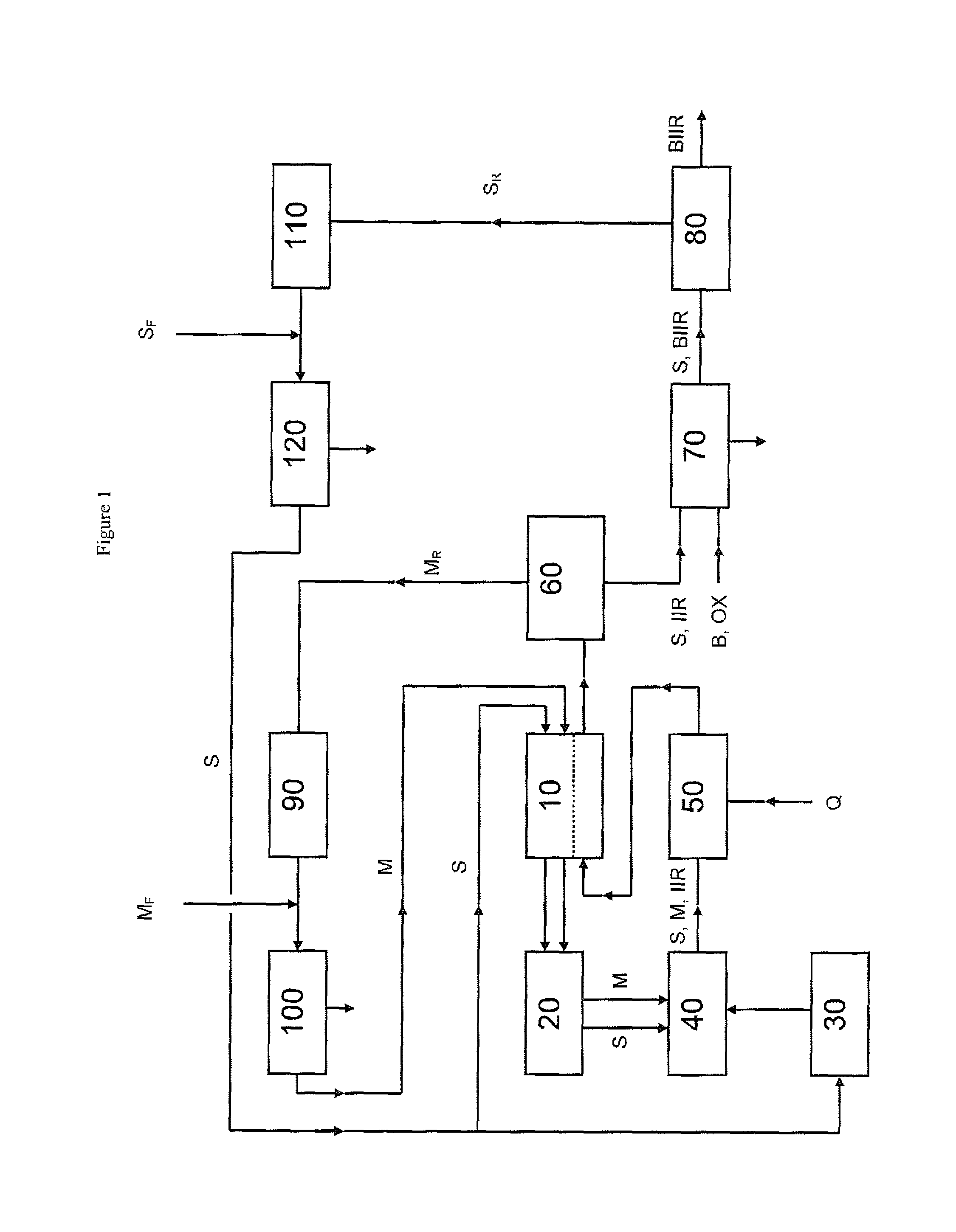Process for producing brominated butyl rubber
a brominated butyl rubber and process technology, applied in the direction of transportation and packaging, non-macromolecular adhesive additives, coatings, etc., can solve the problems of inefficient energy consumption, significant energy consumption in the process of removing all un-reacted components from the rubber slurry
- Summary
- Abstract
- Description
- Claims
- Application Information
AI Technical Summary
Benefits of technology
Problems solved by technology
Method used
Image
Examples
example 1
Polymerization and Distillation
[0147]A reactor of 4 litre total capacity was run in a continuous mode. Feeds to the reactors were 6.438 kg / h of isobutene, 0.150 kg / h of isoprene and 5.382 kg / h of an aliphatic medium comprising[0148]2.0 wt.-% butanes and pentanes having a boiling point below 45° C. at a pressure of 1013 hPa,[0149]97.5 wt.-% pentanes and hexanes having a boiling point in the range of 45° C. to 80° C. at a pressure of 1013 hPa,[0150]0.5 wt.-% hexanes, heptanes and octanes having a boiling point above 80° C. at a pressure of 1013 hPa,
whereby the aliphatic medium comprises less than 20 wt-% of cyclic aliphatic compounds resulting in a monomer / aliphatic medium mass ratio of 55:45.
[0151]As initiator, a 1.5 wt.-% 1:1 molar mixture of diethylaluminum chloride and ethylaluminumdichloride solution in n-hexane activated with 100 mol-% of water based on the aluminium content was used in an amount of 35 g / h.
[0152]The reaction temperature used was −65° C. and a solution having a s...
example 2
Halogenation with Elemental Bromine
[0153]The butyl rubber cement of Example 1 was halogenated using pilot scale batch bromination equipment. A 35 wt.-% hydrogen peroxide solution in water (at a molar ratio of 1.1:1 with bromine to be added) was introduced into this solution and the resulting mixture was agitated at 45° C. for up to 2 minutes prior to the addition of elemental bromine. The amount of bromine added was 21.0 kg per ton of butyl rubber. After a reaction period of up to 20 minutes, sodium hydroxide solution was added to the reaction mixture to neutralize any residual hydrogen bromide, bromine and hydrogen peroxide and to adjust the pH-value to 9.5. The resulting brominated butyl rubber cement was rinsed with water in a 1:1 mass ratio.
[0154]Antioxidants (irganox), stabilizers (paraplex) and calcium stearate were dispersed in the cement before steam injection was used to remove residual solvent. The resulting polymer was dried using a hot mill until less than 0.1% mass loss...
example 3
Halogenation with 48 Wt % HBr in Water
[0157]The butyl rubber cement of example 1 was halogenated using pilot scale batch bromination equipment. A 35 wt.-% hydrogen peroxide solution in water (at a molar ratio of 2.05:1 with HBr to be added) was introduced into this solution and the resulting mixture was agitated at 45° C. for up to 2 minutes prior to the addition of 48% wt hydrogen bromide in water. The amount of hydrogen bromine (48% by weight) added was 49 kg per ton of butyl rubber.
[0158]After a reaction period of 3 minutes, sodium hydroxide solution was added to the reaction mixture to neutralize any residual hydrogen bromide, bromine and hydrogen peroxide and to adjust the pH-value to 9.5. The resulting brominated butyl rubber cement was rinsed with water in a 1:1 mass ratio.
[0159]Antioxidants (irganox), stabilizers (paraplex) and calcium stearate were dispersed in the cement before steam injection was used to remove residual solvent. The resulting polymer was dried using a hot...
PUM
| Property | Measurement | Unit |
|---|---|---|
| pressure | aaaaa | aaaaa |
| boiling point | aaaaa | aaaaa |
| boiling point | aaaaa | aaaaa |
Abstract
Description
Claims
Application Information
 Login to View More
Login to View More - R&D
- Intellectual Property
- Life Sciences
- Materials
- Tech Scout
- Unparalleled Data Quality
- Higher Quality Content
- 60% Fewer Hallucinations
Browse by: Latest US Patents, China's latest patents, Technical Efficacy Thesaurus, Application Domain, Technology Topic, Popular Technical Reports.
© 2025 PatSnap. All rights reserved.Legal|Privacy policy|Modern Slavery Act Transparency Statement|Sitemap|About US| Contact US: help@patsnap.com

